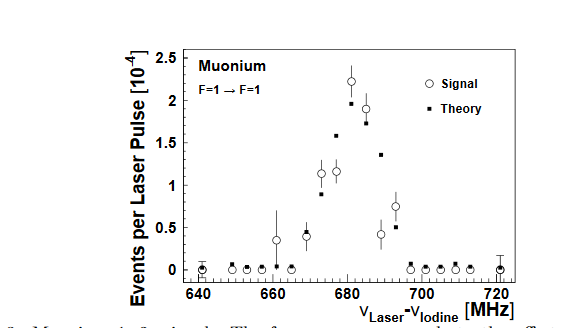Muonium is an exotic atom made up of an antimuon and an electron,1 which was discovered in 1960 by Vernon W. Hughes 2 and is given the chemical symbol Mu. During the muon's 2.2 µs lifetime, muonium can enter into compounds such as muonium chloride (MuCl) or sodium muonide (NaMu).3 Due to the mass difference between the antimuon and the electron, muonium (μ+e−) is more similar to atomic hydrogen (p+e−) than positronium (e+e−). Its Bohr radius and ionization energy are within 0.5% of hydrogen, deuterium, and tritium, and thus it can usefully be considered as an exotic light isotope of hydrogen.
This is the definition of muonium, to contrast with:
Normally in the nomenclature of particle physics, an atom composed of a positively charged particle bound to an electron is named after the positive particle with "-ium" appended, in this case "muium". The suffix "-onium" is mostly used for bound states of a particle with its own antiparticle. The exotic atom consisting of a muon and an antimuon is known as "true muonium". It is yet to be observed, but it may have been generated in the collision of electron and positron beams.
Back to the atom (mu+e-)
Here is an experiment that measured specific energy levels of muonium
The experiment was performed using the intense
pulsed muon source at the ISIS synchrotron of the Rutherford Appleton Laboratory (RAL)
in Chilton, UK. The accelerator operates at 50 Hz repetition rate and provides in its DEVA
beam area 3500
μ
+
per pulse at p=26.5 MeV/c momentum and p/p=10% momentum
bite. Muonium atoms were formed by electron capture after stopping the muons close to
the surface of a target of SiO
2
powder (Cabosil M5,, Cabot Company). About 80 atoms
per pulse left the target through its surface.
Intense laser beams are used to excite the muonium to a higher level .
The 1s-2s transition was detected through the photoionisation of the excited 2s state
in the same laser field.
They found radiation from muons with the specific energy level transition, that showed the bound state for the microseconds the muonium atom lives before the muon decays to a positron +neutrinos.

FIG. 3. Muonium 1s-2s signal. The frequency corresponds to the offset of the laser at its
fundamental wavelength 732 nm from the relevant reference in the
127
I
2
spectrum. The open
circles are the observed signal, the solid squares represent the theoretical expectation based on
This is one example of a specific experiment aiming at high precision comparisons in QED calculations. They have a muon detector .
The original discovery of muonium :
Muonium was identified in 1960 by the groups of Hughes at Columbia and
Telegdi at Chicago [132, 24]. The experiments detected the characteristic signal
of muonium precession in a weak field by recording the high-energy positrons
emitted from polarized muon stops in argon gas.
19
In these circumstances the
muonium atoms were directly formed in their 1S ground state by electron cap-
ture from argon atoms.
Measured the positrons from the decay of the muon. See page 59 here.
So these are not simple experiments for the student lab.

